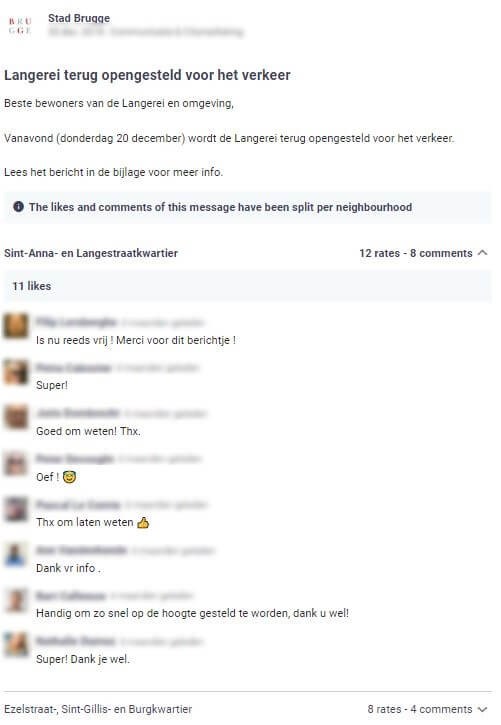City of Bruges on Hoplr: results of a successful pilot project
Hoplr made its debut in the Venice of the North at the end of 2018: a pilot project in collaboration with the City of Bruges. 14 neighbourhoods are activated – which accounts for some 3,500 registered households, more than 5,000 messages and 45,000 responses. But what’s most noteworthy after a couple of months of Hoplr in Bruges? The engagement among citizens.
Pilot project in 9 neighbourhoods
A pilot project was organised in 9 neighbourhoods, as part of ‘The Future of Bruges’, a platform for citizen initiatives and future plans for the city. During this trial period, the local government also gained access to the Service Dashboard.
The City of Bruges selected 9 neighbourhoods in which it wanted to launch the pilot project:

- Kristus-Koning
- Lissewege-Zwankendamme
- O.L.Vrouwe- and Magdalenakwartier
- Sint-Anna and Langestraatkwartier
- Sint Katarina – Sint Trudo
- Ezelstraat, Sint-Gillis and Burgkwartier
- West-Brugge and Steenstraatkwartier
- Sint-Pieters
- Zeebrugge
The City of Bruges chose to distribute the Hoplr invitation letters in collaboration with Sobo. Sobo is a local organisation that offers employment to people with reduced chances on the job market. The City of Bruges also helped with getting the word out about the neighbourhood network, by flyering at various events and posting on their online channels. Mintus – the care association of Bruges – helped with the launch of the pilot project as well. By 2019, the city was able to start communicating with the launched neighbourhoods, by making use the Service Dashboard.
Engaged neighbours
The people of Bruges are fans of Hoplr, that much is clear. In each of the launched neighbourhoods, 10 to 25% (on average 16%) of all Bruges households registered. The neighbourhoods O.L.Vrouwe- and Magdalenakwartier and Sint-Anna and Langestraatkwartier take the cake.
It didn’t stop there. Hoplr’s members’ enthusiasm quickly spread to the surrounding neighbourhoods. It’s possible for citizens to take the initiative to launch a neighbourhood themselves – if they are willing to distribute the invitation letters (1,500 letters on average).

No less than 5 engaged citizens (from Assebroek Noord, De Linde, Sint-Michiels Oost, Sint-Michiels West and Dudzele) rolled up their sleeves and each voluntarily went out for about ten hours to invite their neighbours to Hoplr. The initiator from Zeebrugge had started up the network in his neighbourhood, even before the collaboration between Hoplr and the City of Bruges.
The various events that the Hoplr team attended (such as a neighbourhood event and an info session) also made it clear how excited the citizens are with the arrival of Hoplr. We could always count on a large turnout, curious citizens and many compliments.

Bruges on Hoplr
As mentioned, some 3,500 people in Bruges are already active on Hoplr. So, what’s going on, on the inside of those virtual neighbourhoods? On average, 60 messages and 580 comments are posted per week. 87% of users come log in at least once a week, and 67% of all registered Bruges households actively take part in the conversation.

The people of Bruges post a variety of messages on Hoplr. They use our neighbourhood network to:
- get to know each other better;
- organise activities;
- find, share and borrow items;
- ask for help from a neighbour;
- get recommendations for a trustworthy professional.

Every neighbourhood is different: some use Hoplr mainly to get to know new people, others view the network as a practical tool. People in Bruges appear to be mainly doers. We’ve seen many initiatives and activities popping up.


Some 46 activities have already been organised. The Bruges neighbourhood ambassadors are also some of the most engaged in Belgium. 27 ambassadors in 11 neighbourhoods are ready to answer neighbours’ questions and are in direct contact with the Hoplr team.
City of Bruges and the Service Dashboard
The city of Bruges thinks of Hoplr mainly as a means to bring citizens closer together and to strengthen the social cohesion within local communities.
Besides that, the City of Bruges has access to the Service Dashboard. This is a platform that allows external parties such as cities and municipalities to easily communicate with one, some or all neighbourhoods. Because it is a independent platform, the local government has no access to the Hoplr neighbourhoods or the conversations that take place there. Hoplr is fully in line with the European GDPR.

The Service Dashboard offers a number of functionalities with which the City of Bruges can further improve its services. For example: with the help of the Service Dashboard, the administration was able to post a number of messages in the neighbourhoods already. They have been posting useful updates about events, road works, neighbourhood meetings and so on.


Hoplr has already proved to be a very positive experience for us. Also in terms of policy, Hoplr allows for quick responding and sharing important messages with the neighbourhood.
Ine Plovie, Future Coordinator
Governments can also use the dashboard to collect anonymised and aggregated information, and to launch citizen participation projects. Finally, the administration can use Hoplr to facilitate community care. As such, Mintus too, has access to the Service Dashboard.
Internal communication is important when launching Hoplr. Who will be responsible for posting the messages, how will we organise ourselves,… Many departments within the local government want to make use of Hoplr. Conversely, citizens ask questions that may be directed to different departments. So good organisation is key.
Ine Plovie, Future Coordinator
Conclusion
Hoplr’s pilot project in Bruges has been a successful one to say the least. With Hoplr, Bruges’ neighbours are not only given the opportunity to communicate with each other, the administration of the City of Bruges reaches its citizens more easily and quickly as well. This both promotes social cohesion and stimulates dialogue with the city. Hopefully, we’ll be able to welcome all neighbours of Bruges to Hoplr soon!





